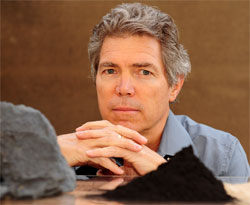Cleaner, Meaner, Coal
By Anna Lynn Spitzer
Irvine, Calif., April 2009 -- While scientists continue to make steady progress in the search for alternative energy sources, one immutable fact remains: it takes time to develop and broadly implement revolutionary technologies – 20 to 30 years, most likely. Meanwhile, coal continues to supply the vast majority of our electrical energy needs. Doesn’t it make sense in the interim to improve coal-combustion tools to reduce pollutants?
UCI engineering professor Derek Dunn-Rankin thinks so. He is developing new technologies that can be implemented easily in existing power plants to do just that. “You can make a very small change in
the efficiency or utilization of coal, and because so much of it is used, it can make a huge environmental impact,” he says.
It’s well known that coal combustion releases carbon dioxide, which experts agree has long-term globalwarming effects on the environment.
But in the shorter term, burning coal releases other pollutants as well,
including oxides of nitrogen and mercury, which affect the air we breathe
every day.
|
No Two Coals Alike
Dunn-Rankin says output of those pollutants can be reduced with simple fixes based on the heterogeneous fossil fuel’s specific properties. “Really, there is no such thing as coal; it’s actually many different kinds of coal,” he says.
There are five generic categories of coal, each of which reacts differently to combustion due to variables, including: what geographic area and even specifically, what seam it originated in; what minerals it contains; and the amounts of moisture, hydrogen, carbon, oxygen and nitrogen it holds.
The research, which is sponsored by General Electric and the UC Discovery program, employs chemical-kinetic descriptions of the reactions generated by these heterogeneous fuels. This information allows power plant operators to model the variables and implement subtle production changes, such as the way air is injected, to maximize efficiency from different coals while meeting emission requirements.
“When the fuel changes, the combustion can change and different kinds of pollutants are produced,” Dunn-Rankin says. “In terms of designing power plants for the future, there isn’t a good understanding of what’s driving the fundamental reactivity, so our objective is to provide that information.
”Reusing Residuals
Residual ash from coal can be recycled into building materials, primarily as additives to cement and concrete. But if it contains too much carbon, it can be relegated to landfills, certainly a less satisfactory option. Slight changes in the combustion process that may reduce emissions can lead to excess carbon in the ash, making adjustments especially important. “The byproduct of coal can be sellable or useless and a disposal challenge for very, very small changes in the combustion behavior,” Dunn-Rankin says. “The idea is to give manufacturers a very clear handle on exactly what the key triggers are for keeping them safely below the carbon content required for clean ash while also reducing the nitric oxide emissions.”
Dunn-Rankin is careful to differentiate between carbon emissions and those from other pollutants. The retrofits suggested by his research do not reduce the release of carbon dioxide during combustion, but maximizing efficiency reduces the overall level of carbon emitted into the atmosphere. “Because so much coal is burned,” he says, “the carbon dioxide reduction from a very small change in efficiency has a huge impact on the total carbon emitted.
“If coal power plants could improve their efficiency by one percent, that is equivalent to the entire installed wind energy.”
Carbon-Neutral Uses
His research also has applications for burning biomass, which is carbon-neutral and will most likely be used to a greater extent in the future.
“Biomass is even more heterogeneous than coal,” says Dunn-Rankin. Biomaterials like wood, sawdust, corn husks and ground rice hulls all have different burning characteristics that require similar adjustments in the combustion process to maximize efficiency and minimize emissions.
The technologies currently are being tested in co-firing applications with both coal and biomass, but could be adapted for biomass combustion alone. “When we get to the point in the future here we’re burning biofuel instead of coal, we won’t have the carbon issue at all,” he says.
For now, however, Dunn-Rankin admits to some pessimism about the realities of energy production. “My view is that any energy source that can be burned will be burned,” he says. “So we want to make it burn slowly and [to the best of our ability] so we don’t go through it so quickly.
“And,” he adds, “we have to make sure it doesn’t kill everyone in the process.”


